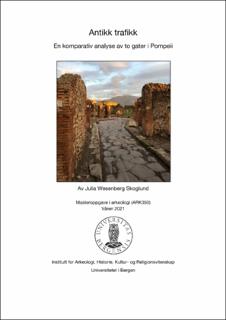| dc.contributor.author | Skoglund, Julia Wesenberg | |
| dc.date.accessioned | 2021-06-16T01:08:26Z | |
| dc.date.available | 2021-06-16T01:08:26Z | |
| dc.date.issued | 2021-06-02 | |
| dc.date.submitted | 2021-06-15T22:00:22Z | |
| dc.identifier.uri | https://hdl.handle.net/11250/2759629 | |
| dc.description.abstract | I denne oppgaven tar jeg for meg gatene i Pompeii, et tema som tilbyr et enormt kildemateriale. Jeg har valgt to gater som ligger parallelt med hverandre i gatenettverket, og problemstillingen i denne oppgaven går ut på å besvare hvilke likheter og forskjeller det er mellom disse to. Gatene blir undersøker hver for seg. En viktig del av arbeidet er derfor å bruke kilder som har kartlagt det fysiske materialet av Pompeii, i tillegg til en forståelse av hvordan tidligere forskning innenfor dette temaet har blitt utført. Målet med analysen er å se hvordan forskjeller og likheter kan forklares, og hva som har formet gatene. Dette omhandler både bygninger, kommersielle aktiviteter og arkitektur som kan belyse aktiviteten som fant sted i gaterommet. Jeg foretar en komparativ analyse, hvor det blir synlig at gatene deler flere likheter på et makronivå enn de gjør på et mikronivå. Forskjellene er mer fremtredende ved en nærmere undersøkelse, der antall spise- og serveringssteder og butikker blir kartlagt, og gatenes arkitektur blir sammenlignet. Det er i all hovedsak en makroanalyse med formål å forstå det helhetlige bilde av gatene, og hvordan deres like eller ulike karakter kan hjelpe gi et innblikk i hvordan det antikke gaterommet i Pompeii var. | |
| dc.description.abstract | This paper explores the streets of Pompeii that was buried with the city in AD 79 due to the eruption of Mount Vesuvius. Two streets that runs parallel to each other in the street network will be analyzed, the goal being to answer what similarities and differences there are between these two. The analysis starts off with a closer examination of each street separately, including the surroundings such as buildings, commercial activities and architecture that may shed a light on the activity that took place in the streetscape. An important part of this research has thus been the registration and mapping of the archaeological remains of Pompeii. This part of the paper leads up to the comparative analysis of the streets, where the aim of the analysis is to see how differences and similarities can be explained. This paper is essentially a macro analysis with the aim of understanding the overall picture of the streets, and how the streets similar or different character can help give an insight into what the ancient street space in Pompeii was like. Through the analysis and the discussion, it becomes more apparent that the streets share greater similarities at a macro level than they do at a micro level. The differences between them are more prominent through a closer examination, revealing a difference in commercial activity and the architectural forms. | |
| dc.language.iso | nob | |
| dc.publisher | The University of Bergen | |
| dc.rights | Copyright the Author. All rights reserved | |
| dc.subject | Pompeii | |
| dc.title | Antikk trafikk: En komparativ analyse av to gater i Pompeii | |
| dc.title.alternative | Ancient traffic: A comparative analysis of two streets in Pompeii | |
| dc.type | Master thesis | |
| dc.date.updated | 2021-06-15T22:00:22Z | |
| dc.rights.holder | Copyright the Author. All rights reserved | |
| dc.description.degree | Arkeologi mastergradsoppgave | |
| dc.description.localcode | ARK350 | |
| dc.description.localcode | MAHF-ARK | |
| dc.subject.nus | 713306 | |
| fs.subjectcode | ARK350 | |
| fs.unitcode | 11-22-0 | |
